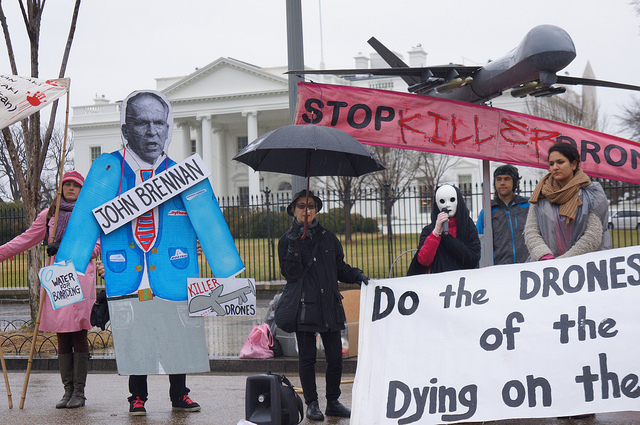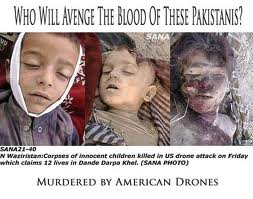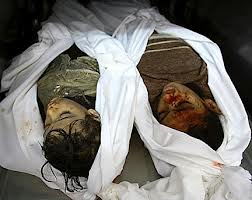Pakistani Army Maj. Gen. Asim Saleem Bajwa discusses the impact the “war on terror” has had on Waziristan. “The motto we adopted was ‘build better than before,'” he told NBC News.
In the wake of a major operation in 2009, the Pakistan Army has largely succeeded in pushing back the militant threat from South Waziristan. The area is now considered secure and tribal communities that fled the fighting are starting to return.
Bajwa realized that if the tribal communities weren’t given something to replace their previous way of life, they might again become willing to help or harbor terrorists.
“Looking at it in a larger security context, you can’t really separate development from security,” said Bajwa. “So we’re doing this to serve the larger purpose as well. “
In the village of Chagh Malai, the army constructed a marketplace, complete with dozens of individual shops carrying everything from cloth to medicine to household supplies. Tribal communities here previously maintained individual shops in their homes or in roadside stalls. The marketplace, army commanders said, gives them a sense of community and a central commercial gathering place. They have plans to build 30 complexes like it across the area.
Tribal elder Akhlas Khan excitedly toured the market last week, introducing store owners and showing off inventory.
“Previously, I’d have to travel four or five hours to get these,” he said, gesturing to a small shop carrying electrical goods. “Now, I only need to come here!”
Pakistan Army commanders on the frontlines of the battle for Waziristan talk about the challenges they face and how important it is to develop this isolated part of the world. NBC News’ Amna Nawaz reports.
TALIBAN AND THEIR PUBLIC FLOGGINGS AND EXECUTIONS
In Sararogha, South Waziristan, an 88-shop market complex now stands at the same site the Taliban — once headquartered here — used to use for public floggings and executions.
“These communities, the vast majority of them, have seen the worst kind of atrocities known to the human race,” said Maj. Gen. Ahmed Mahmood Hayat, commander of the Pakistan Army’s 40th Division in South Waziristan.
“They’ve been subjected to coercion — mental and physical — by the terrorists in order to acquiesce them to support,” he added. “They’ve seen their loved ones being butchered in front of their own eyes. So that is the kind of trauma this society has seen. And therefore the greater the challenge to bring back the confidence of these people into the state machinery.”
Trading routes and schools
At the heart of the army’s plans to rebuild the area is a 370-mile road — funded in large part byUSAID money. The road, half of which is complete, will connect the isolated and insular tribal communities to each other, as well as the rest of mainstream Pakistan and to trading routes across the border in Afghanistan.
When finished, the roadway will offer a third link from Pakistan to Afghanistan, and the army hopes, will encourage business development along its path through Waziristan.
In addition to the road project, the army has taken on development projects far outside its traditional roles.

Waj S. Khan / NBC News
A tribesman waits in line at a ‘Distribution Camp’ set up on the side the newly constructed Tank-Makeen road in South Waziristan. Radios and mattresses are the items of choice popular among locals, who belong to one of the most impoverished communities in Pakistan.
Along with the markets, two military schools, known here as Cadet Colleges, were built in South Waziristan to offer young men a rigorous education and boarding-school environment, unlike any educational opportunity available in the region before.
Col. Zahid Naseem Akbar, principal of the Cadet College, Spinkai, said he hopes the school will gives boys in the area the same opportunities as those elsewhere in the country.
“They have the same potential as any other citizen of this country has,” Akbar said. “And I think we owe it to them that we provide them the opportunity to join the mainstream.”
The army is overseeing the rebuilding to schools demolished by the Taliban and building schools for the first time in some areas, including for girls. The military established the Waziristan Institute for Technical Education — a vocational school to train young men who missed their early education during Taliban rule.
And the army is restoring water supplies and electrical systems and funding what they call “livelihood projects,” training and empowering local small businesses in everything from honey bee farming and fruit orchards, to auto repair and transport services.
“The strategy that the Pakistan army has adopted is a people-centric strategy,” Hayat said. “So the more areas you’ve able to clear, the more infrastructure you’re able to build, the more people you are able to bring back and sustain. Provide them economic opportunities. That is the measure of success.”
Ideal habitat for Taliban
Frontline commanders all say the battle for Waziristan will not be won with hearts and minds alone. Security operations continue, gradually increasing what they call their “elbow space” in the region.
Both North and South Waziristan feature snow-capped peaks, deep valleys, hidden caverns, and daunting mountain ranges which provide natural cover. It’s the ideal habitat for the Taliban and other groups seeking refuge and covert routes for travel between Afghanistan and Pakistan.

Amna Nawaz / NBC News
A Pakistani soldier hikes toward an observation post near the border between North and South Waziristan. With little infrastructure, funding, or investment, many in the area make their living by engaging in criminal activity, cross-border smuggling, or signing up to join militant groups.
Atop a 6,000-foot high post in South Waziristan, Brig. Hassan Azhar Hayat said despite securing the area, the struggle to hold it against “pockets of resistance” is constant. His troops, he says, still carry out targeted operations on an almost daily basis.
“That’s why the military’s presence is so important here right now in this area, that we keep increasing our perimeter of security,” Hayat said. “This is guerrilla warfare. It cannot happen that you’re able to eliminate the complete Taliban in any form. So it is different warfare altogether.”
North Waziristan remains the only one of the seven tribal agencies in the Federally Administered Tribal Areas (FATA) in which the Pakistan military has not launched a significant military operation.
Despite public pressure from the U.S. to act, Pakistani commanders there cite the complexity of the region, the politicized nature of the debate, as well as the increasing stakes of the approaching 2014 drawdown of troops across the border as critical to their operation’s timeline.

Mohsin Raza / Reuters
Images of daily life, political pursuits, religious rites and deadly violence.
Maj. Gen. Ali Abbas, the commanding officer of the 7th Infantry Division of the Pakistan Army, currently stationed in North Waziristan, said his region must be considered separately because of the number of influences at play. However, 40,000 troops are stationed in North Waziristan, which shares a 113-mile border with Afghanistan,
“North Waziristan is not like any other agency in Pakistan,” Abbas said. “It’s very different. It’s very complex.”
Despite the territory won and economic investments made, there is concern within the local community about a backslide to the time of Taliban rule. Khan, the tribal elder, doesn’t want the army to leave until the entire area has been won and a civilian administration has taken over control. Army commanders say their commitment is clear.
“The army will stay here as long as the army is desired by the local people to stay here, and mandated by the government of Pakistan to stay here,” Hayat said. “We’re here for the long haul. This is our backyard. We cannot ignore it.”
Communities in South Waziristan have been slow to return to the region after the end of military operations. In some sections, crumbling homes and untended stretches of land dot the landscape. Small clusters of mud-walled homes sit empty. Army commanders hope as word of their development efforts spreads, more of those who fled the fighting will return. They are taking, they say, a very long view.
“If we really want to change this area, the approach is to do it over one generation,” Bajwa added. “Look at the next 10 years. If we put a child in the school now, and 10 years on, we bring him out of the school, we put him into a college, I think we have done our job.”
Reference:
By Amna Nawaz and Waj S. Khan, NBC News



























